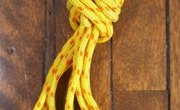Trying to catch deer without a gun can be difficult because they are so elusive and quick. Creating a snare trap to catch one is a good survival skill to have when you are in need of food in the woods. The hardest thing to obtain to make it is a strong durable cord. Other than that, you are using natural elements and materials in the wilderness to create the snare trap.
Items you will need
Durable string or cord
Tree trunk
2 to 3 thick, sturdy sticks
Examine the ground in the woods for multiple deer tracks, especially around watering holes where they come to graze and drink. Look for high-traffic areas to set up the snare traps. Pick an exact location where you want the trap set up.
Obtain a string or durable cord. Since you are catching larger game, you need a thick cord such as a parachute cord or thick shoelace. Fishing line and regular twine or string will not hold.
Tie a slip knot in the cord. The loop in the slip knot needs to be large enough for a deer's head to slip through. Fit your head through it, and then make sure it is about the width of 1.5 of your head size.
Look for a close by tree trunk. Tie the other end of the cord securely around it, up at least 4 feet off the ground, but not higher than 5 feet. If you cannot find a close enough tree trunk, than find a long thick stick to anchor in the ground a couple feet away. It will have to be as large as a walking stick. Anchor this stick firmly into the ground at least 3 feet from the pathway, and tie the cord around the top of this stick.
Search for two thick sticks that are at least 4 feet tall, but not taller than 5 feet. Ideally, you want the sticks to have a wishbone shape on one end, or a hook like appearance to anchor the string. Firmly plant one of these sticks into one side of the ground where the trap will be set. Then, stick the other one into the other side of the ground. The goal is to have the deer walk between these two sticks, where the snare will be anchored.
Hold onto the slip knot part of the string. Set one side of the noose on top of or around one of the sticks, and repeat the process with the other side of the noose, on the other stick. You want the loop hole wide and open, anchored by these sticks, so that when a deer walks down the path it will walk right into the noose, creating it to tighten.
Wait for a deer to show up. This could take a long time, but if you are in a high traffic area for deer, hopefully more than one will appear. Once the deer walks through the trap, the noose will tighten.



